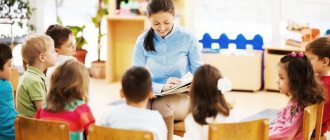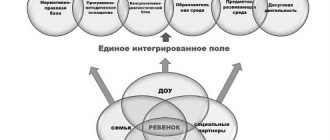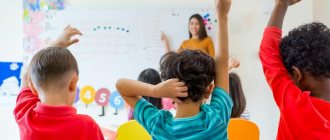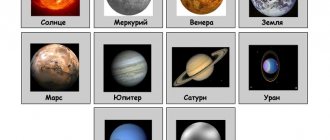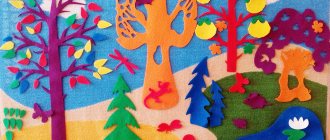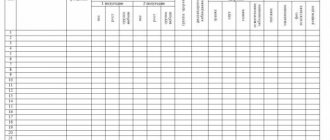A job description for a kindergarten teacher is needed as an addition to the employment contract, which explains its points. Although it is not mentioned in modern legislation, business practice and recommendations of regulatory authorities lead to the fact that most employers include it in standard labor documentation packages. As a legally binding document, this instruction must be correctly written and formatted.
- Form and sample
- Online viewing
- Free download
- Safely
FILES
Preschool education - main goals
The main directions of preschool education of a child are cultural, psychological, physical and social development.
That is, the goal of education before school is the development of the child in all personal parameters. And it is not so important when a child, for example, learns letters - at four or five years old. The main thing is that he develops an interest in new knowledge, skills and abilities. It is these areas of child upbringing that are priorities in preschool educational institutions - kindergartens. The main task of educators is general developmental education. It should ensure the full physical and psychological development of children.
Also, as the goals of preschool education, one can note the creation of mental comfort, without which the full psychological development of a child is impossible. And moral and patriotic education, which is designed to sow in the child’s soul love and respect for parents - first of all, then for relatives and friends. These are the foundations that will subsequently allow the child to develop the ability to take care of and appreciate his home, street, school, nature and all living things. From these goals flow the tasks that teachers set for themselves in raising a preschooler.
Main tasks in preschool education
There are several main tasks designed to ensure the full development and upbringing of a child up to seven years old. This is introducing children to a healthy lifestyle, developing a child’s positive sense of self, ensuring his emotional well-being, stimulating activity, curiosity, and the desire for creative self-expression. It is also the development of competence in communicating with peers and adults, identifying and developing the child’s abilities. These are general tasks that should be followed not only by kindergarten teachers, but also by the child’s parents.
There are also narrower tasks prescribed in the standard regulations on a preschool educational institution. These include: protecting life, strengthening the psychological and physical condition of the child, instilling respect for human rights and freedoms, correcting (if necessary) deficiencies in the physical and psychological development of children, interaction with families in order to provide advisory or methodological assistance to parents.
A conscientious attitude towards the implementation of these tasks on the part of teachers in kindergarten and people surrounding the child at home will ensure the child’s full psychological and physical development and prepare him for more adult, school life.
Specifics of the teacher’s work, his professional skills
PEDAGOGICAL ABILITY is the conscious mastery of the subject of pedagogical activity by a set of mental and practical actions aimed at achieving the goals of teaching and education and motivated by his professional worldview.
FUNCTIONS OF A TEACHER - a set of professional responsibilities, the fulfillment of which ensures the successful achievement of the goals and objectives of raising children.
A preschool teacher performs two main functions
I) maternal - manifests itself in ensuring a good emotional state of each child and group, in protecting their life and health, in a caring, affectionate attitude towards children; 2) developing. the function includes a system of pedagogical skills that a teacher must have.
I. Gnostic skills give the teacher the opportunity to understand the subject of activity, allow them to see in their pupils the manifestation of the cognitive, volitional, emotional spheres, motives of his behavior, abilities, temperament; identify relationships between children, determine the characteristics of the family microenvironment. This includes the ability to objectively evaluate the effectiveness of the applied methods of education and training, to take into account the experience of others in order to transfer its advanced, creative content into one’s teaching practice.
P. Constructive skills are needed by the teacher in order to see the “tomorrow” of the pupils, the development of each child and the entire group, and plan educational work; allow the teacher to competently select factual material for different types of activities depending on the tasks of education and training at each age stage.
Sh. Communication skills ensure the establishment of pedagogically appropriate relationships with individual children and with the entire group, with parents of students, and work colleagues.
GU. Organizational skills ensure the organization of various forms of activity (frontal, group, individual), own teaching activities and work with parents of children in their group; are manifested in the ability to organize interesting activities for children and adults, to “infect” them with your energy and initiative.
U. Special skills are manifested in the teacher’s ability to read works expressively, draw well, sing, dance, sculpt, design, make visual aids, toys, attributes, master basic types of movements, use technical teaching aids, etc.
At the level of modern requirements, the question of multi-level training of professional personnel for the preschool education system is raised. The first stage of higher pedagogical education provides broad-profile training. Stage II - bachelor's degree, stage III - master's degree. Teachers will improve their professional level and qualifications at courses and seminars that are organized at institutes for advanced training. For this purpose, scientific and practical conferences and lectures on current issues of education and training are also held periodically. Advanced training is facilitated by methodological associations, where issues of methods of working with children are discussed, and advanced and innovative methods are proposed for adoption.
Directly in kindergarten, advanced training is carried out in various forms. work, which includes: open classes, teacher councils, seminars, pedagogical discussions, business games, etc.
Systematic self-improvement, self-education and self-education help the teacher’s professional growth, his familiarization with advanced ideas in the field of psychological and pedagogical sciences, universal and national values. Activation of pedagogical creativity is facilitated by mastery of psychological diagnostics and autodiagnostics, training. He must be patient, love children, be kind and fair, be able to sympathize, and be responsive. At the same time, he must be organized, consistent, demanding, and hardworking. A teacher needs to be, first of all, a highly moral person. Important personal qualities are cheerfulness, optimism, and a sense of humor. A person is not born with these qualities; they must be developed in oneself. A necessary quality is the ability to keep a promise given to children. Unity of word and deed is a necessary quality for an educator. The absence of this undermines not only the authority of the teacher, but also the child’s faith in people, in their honesty, and the authority of the teacher.
33 MENTAL EDUCATION - the purposeful activity of educators to develop the child’s mental strength and thinking, to form his system of mental actions and cognitive abilities.
The mental education and development of a child cannot be considered in isolation from his mental development as a whole, from the wealth of the child’s interests, his feelings and all other features that create his spiritual appearance. The goal of mental education of preschoolers cannot be understood in a simplified way - as to give children as much knowledge as possible about the environment; it is much more important to develop in them general methods of cognitive activity (the ability to analyze, compare, generalize), develop speech, create a need to acquire new knowledge, master ability to think. The rate of mental development of preschoolers is very high in comparison with later age periods. Any defects in the mental education of preschoolers are difficult to correct at an older age and have a negative impact on the entire further development of the child. The role of mental education is especially important in preparing children for school. Mastering a stock of knowledge, developing mental activity and independence, acquiring intellectual skills and abilities are important prerequisites for successful learning at school and for preparing for future work.
The methodological basis of mental education is the philosophical theory of knowledge, which states that the path of cognition of the real world is carried out in this way: “from living contemplation to abstract thinking and from it to practice - this is the dialectical path of cognition of objective reality.”
The first stage of cognition is living contemplation, during which direct sensory perception of objects and phenomena is carried out with the help of sensations and perceptions. In preschool age, sensory perception is the main source of children's knowledge about the environment, the first stage of their knowledge of the real world.
Thus, the child’s mental development begins with direct sensory perception of the environment (the pedagogical requirement for the clarity of learning)
the second and highest level of cognition is abstract thinking. Sensory perception constantly enriches thinking with concrete, real, “living” images and facts, and abstract thinking based on these facts makes it possible to penetrate into such properties and relationships of things that are inaccessible to living contemplation. The essence of objects, phenomena, and their relationships are revealed to the child through thinking. Abstract thinking allows you to economically spend a child’s mental powers, create in his memory entire sets of ideas that the child uses by analogy when studying new objects and phenomena. The mental operations that a child gradually masters: analysis, generalization, classification, decision - are an example of the economical work of the human brain.
Practice plays a decisive role in the knowledge of objective reality. It proves the strength, power, and truth of human knowledge. In the play, work, and educational activities of children, the truth of the acquired knowledge is verified. Practice is not only a criterion of truth, but also a source of knowledge. Through play and work, children easily and imperceptibly master a large amount of knowledge, skills and abilities. The process of cognition has an activity-active character. Activity is inherent in human sensitivity itself. The sense organs function due to the realization in them of the ability to reflect. A child is born with unconditioned reflexes. On their basis, numerous conditioned reflexes are formed. The formation of conditioned reflexes is the establishment of a neural temporary connection in the human cerebral cortex. These temporary connections are the material basis of all knowledge, skills, habits acquired by a person. The external stimulus for a small child is the direct influence of objects and phenomena of the surrounding world. These stimuli are perceived by the senses (analyzers). Ya.P. Pavlov called them signals of the first signal system. The functioning of the senses is closely related to the needs of the young child. First, these are organic needs, the satisfaction of which is necessary to preserve life. Later, other needs appear: the need to communicate with adults, the need for active movements, and active actions with objects. In activities with objects, the child learns the properties of objects, qualities, and connections between them. The child’s activity is of an indicative and exploratory nature.
In the process of acting with objects, the child develops visual and effective thinking. This is the most elementary form of thinking that arises in early childhood. In the process of interacting with objects, the child remembers images of objects. Their perception is usually accompanied by appropriate words from adults. There is an interaction between sensory perception and the word, i.e. between I and P signaling systems. The repeated coincidence of a word and an action, a word and the quality of an object leads to the fact that only after the spoken word of an adult does a visual image of the named object appear. This is how a new, more complex form of thinking develops— visual and figurative. With its help, the child solves a number of problems in his mind, without the participation of practical actions - he operates only with images. A preschooler is interested not only in a new subject in itself. He wants to know about its purpose, structure, method of use. The motive for acting with objects is cognitive interest.
The development of cognitive interests in preschoolers is also reflected in the growing desire to engage in mental activity. The child asks adults a lot of questions, likes to compare things and phenomena, and argue. Adults should support curiosity and encourage the child to find a solution to a mental problem. A new type of activity is emerging—mental activity. The child comprehends the action, sets a goal, plans, and selects ways to achieve it. The child is already moving to a new stage of mental development.
Children need to be taught to meaningfully perceive a word, taught to understand its objective content, what action or quality it means. The word is formed as a generalized concept, cut off from its original specific figurative content. A conceptual or verbal-logical form of thinking appears. Often adults strive to quickly develop the conceptual form of thinking in preschoolers, but do not pay enough attention to the development of the first two forms of thinking. This negatively affects the mental and general mental development of children. The conceptual form of thinking develops successfully only when the visual-effective and visual-figurative forms of thinking are well developed. They are the foundation on which conceptual thinking is built.
Tasks of mental education of preschool children:
I) formation in children of a system of elementary knowledge about objects and phenomena of the surrounding life;
2). formation of skills and abilities of mental activity, development of cognitive interests and abilities;
3) formation of cognitive interests and curiosity;
4) teaching children to do mental work.
In preschool age, various means of mental education are used: play, work, constructive and visual activities, training.
A game
- the practice of a child’s life, therefore it primarily reflects what has already been perceived by the child before.
But during the game this knowledge is transformed and improved. Thanks to speech, knowledge formed at the level of visual and figurative representations is translated into speech and, therefore, generalized. There is a transition of knowledge to a new level - verbal-logical.
The game also expands knowledge through actions with objects, the exchange of thoughts between players, and advice and explanations from an adult.
Children's cognitive interests are also formed through play. Interest in the content of the game is transferred to the phenomena and events themselves.
During construction
Specific requirements are imposed on the child’s mental activity: purposefully perceive an object, see its parts, their relationships, the ability to visually divide an object into individual elements and correlate them with existing details, plan activities, etc. Design contributes to the formation of more accurate, specific ideas about an object, and develops the ability to see what is common and unique in a whole group of objects.
In the process of visual activity
There is an intensive formation of sensory abilities and mental actions (dividing a whole into parts, the position of an object in space, color perception, etc.).
Labor activity
contains enormous opportunities for the mental education of children.
Each work task for a preschooler represents a mental task. He must understand what needs to be done, why, how it should be done, analyze the conditions for completing the task, carefully examine the material, tools, evaluate their properties, suitability of the tasks. The child must have certain knowledge, skills and abilities. Work influences the development of children's cognitive interests. The most significant means of mental education is
training . During the learning process, children develop thinking and speech, and develop cognitive interests. Children master the educational activity itself.
42 METHOD (gr. - the path to something) means a way to achieve a goal, a certain ordered activity. TRAINING METHOD - a method of ordered interconnected activity of the teacher and students, activities aimed at solving the problems of education, upbringing and development in the learning process. RECEPTION - part of the method, its specific element. CLASSIFICATION OF TEACHING METHODS is a system ordered according to a certain criterion. In modern didactics, there are various classifications of teaching methods (see table). The age characteristics and capabilities of preschoolers correspond to a classification according to which methods are divided according to sources of transmission and: the nature of information perception (E.Ya. Go-lant, S.I. Petrovsky).
Visual – observation, demonstration, use of TSO; Verbal – explanation, story, reading, conversation
Practical and game - exercise, game methods, elementary experiments, modeling
Visual methods and techniques - their use corresponds to the didactic principle of clarity and is associated with the characteristics of children's thinking. Observations
e is a child’s purposeful, systematic perception of objects and phenomena of the surrounding world, in which perception, thinking and speech actively interact.
Using this method, the teacher directs the child’s perception to highlight the main, essential features in objects and phenomena, to establish cause-and-effect relationships and dependencies between objects and phenomena. In teaching children, observations of various types are used: I) of a recognizing nature, with the help of which knowledge is formed about the properties and qualities of objects and phenomena (shape, color, size, etc.); 2) for the change and transformation of objects (growth and development of plants and animals, etc.) - provides knowledge about processes and objects of the surrounding world; 3) reproductive nature, when the state of an object is established based on individual characteristics, and the picture of the entire phenomenon is determined in part. The demonstration method
includes various techniques: a) showing objects is one of the most common teaching methods: children look at doll furniture and clothes, dishes, household items, tools, equipment for drawing, modeling, appliqué, etc.; b) showing a sample is one of the techniques used when teaching visual arts and design. The sample can be a drawing, applique, or craft;
c) demonstration of a method of action - used in classes on the development of movements, music, artistic activities, etc., it must be accurate, expressive, divided into parts; may be complete or partial; d) demonstration of pictures and illustrations helps children imagine those aspects and properties of the objects and phenomena being studied that they cannot directly perceive. Using TSO
— in teaching preschoolers, demonstrations of transparencies, filmstrips, and films are used.
Recently, computers have been used. This method allows you to show children those phenomena of life with which direct acquaintance is impossible; makes the learning process more attractive. Verbal methods and techniques - their effectiveness largely depends on the teacher’s own speech culture, on its imagery, emotional expressiveness, and accessibility for children’s understanding. Explanation
is used in the process of observing phenomena and examining objects, paintings, during exercises, etc.; with its help, children’s immediate perceptions are clarified; should be expressive, emotional, accessible to children. A story is a lively, imaginative, emotional presentation of events containing factual material. One of the most emotional learning methods. The narrator has the opportunity to freely communicate with children, notice and take into account their reactions.
Teacher's story
: must be an example of literary correct, figurative and expressive speech.
A children's story
can be a retelling of fairy tales, literary works, stories based on paintings, objects, from childhood experience, creative stories.
Reading
expands and enriches children's knowledge about the environment, forms children's abilities to perceive and understand fiction.
40 41 FORM OF TRAINING ORGANIZATION is a way of organizing training, which is carried out in a certain order and mode. The forms differ in the number of participants, the nature of interaction between them, methods of activity, location, etc. In kindergarten, frontal, group and individual forms of organized education are used.
The main form of organizing children's education in kindergarten is classes. They are organized and conducted by the teacher in accordance with the “Program of education and training in kindergarten”. Classes are held for children of all age groups in kindergarten. The daily routine of each group determines the time of the lesson, usually in the morning. (See tables No. 3, 4) Classes are organized in all areas of educational work with children: familiarization with the environment, speech development, musical education, visual arts, design, formation of elementary mathematical concepts, physical education. The lesson can be divided into three main parts.
The first part is introducing children to the topic of the lesson, defining goals, explaining what children should do. The second part is the independent activity of children to complete the teacher’s assignment or the child’s own plans. The third part is the analysis of the task completion and its evaluation. In recent years, a search has been made for ways to improve teaching in kindergarten, and the shortcomings of frontal forms of conducting classes are pointed out: no more than 1/3 of the group actually works in such classes (the most active children); a school form of organization is used (lesson type) with all the requirements for arbitrary behavior, which is not yet entirely accessible to preschool children; classes are often formal in nature (without feedback and actual developmental tasks). The advisability of conducting classes with subgroups of children is noted
